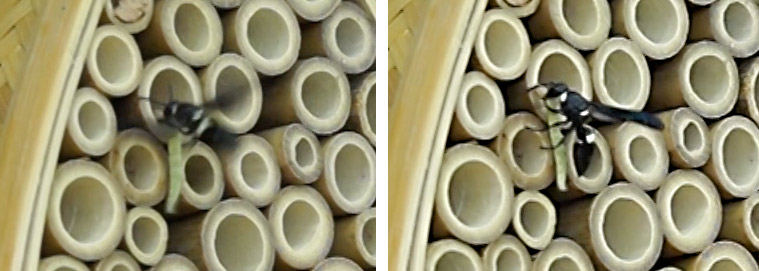In a post published on February 3rd, I described the Black and White Potter Wasps (Monrobia quadridens) that were nesting in our mason bee house last summer. The females uses mud to construct cells inside the bamboo tubes. An egg will be laid in each cell. But what will the larva that hatches from the egg eat? Most butterflies, for example, lay their eggs on a suitable host plant, and the larvae can just start eating the substrate. They are herbivores and eat only plants.
Black and White Potter Wasp larvae, on the other hand, are carnivores, as are the larvae of most wasps. Meat must be provided for them. This is accomplished by the parents. Black and White Potter Wasp parents are expert hunters, and they search diligently for small caterpillars. When a caterpillar is located, the parent wasp expertly stings it in such a way as to paralyze it, but not to kill it. It then carries the victim back to its nest, places it in a newly-constructed cell and lays an egg on it. Additional caterpillars are stung and brought to the nest to provide enough food for the larva to fully develop and pupate.
If the caterpillars were simply killed rather than being alive, but paralyzed, they might rot before the larva had time to eat them all. When the tube is full of caterpillars and wasp eggs, it is sealed with a mud plug.
The two photographs above show a Potter Wasp arriving at its nest with a small green caterpillar.
The video below shows two clips of Potter Wasps returning to their nest in the bamboo tubes of our mason bee house. In each case, they are carrying a small green caterpillar. If you look closely, you can make out the caterpillar being held below the wasp’s body, particularly in the second clip.

